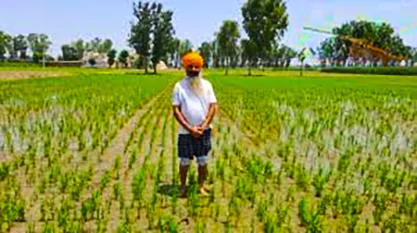This Article sheds light on innovative farming techniques, including herbicide-tolerant crops and new cultivation methods like Direct Seeded Rice (DSR) and Zero-Tillage (ZT) wheat, offering sustainable solutions to these challenges.

Innovations in Sustainable Agriculture
- Water-Efficient Rice Cultivation and Zero-Tillage Wheat
- Water-Saving Techniques in Rice Farming: Efforts are being made to cultivate rice with reduced water usage and eliminate the practice of burning leftover straw post-harvest.
- Zero-Tillage Wheat: The focus is also on growing wheat without traditional ploughing and land preparation, which helps minimize soil disturbance.
Enroll now for UPSC Online Course
Sustainable agriculture
- It is an integrated system of plant and animal production practices.
- This practice satisfies human needs while ensuring environmental quality and natural resources.
- It aims to use non- renewable resources efficiently.
|
- Herbicide-Tolerant Crop VarietiesAdvancements in Herbicide Tolerance: New crop varieties and hybrids have been developed to tolerate the herbicide Imazethapyr, which is effective in controlling weeds and grasses that compete with crops for essential resources like nutrients, water, and sunlight.
- Public and Private Sector Involvement: Both public and private entities are actively involved in breeding these herbicide-tolerant crops.
- New Varieties of Rice
- Kharif Season Rice Varieties: The Indian Agricultural Research Institute (IARI) and Savannah Seeds Pvt. Ltd have introduced two basmati rice varieties (Pusa Basmati 1979 and Pusa Basmati 1985) and two non-basmati hybrids (Sava 134 and Sava 127).
- These contain a mutated acetolactate synthase (ALS) gene, enabling the use of Imazethapyr to manage weeds like Echinochloa colona (jangli chawal), Cyperus rotundus (motha), and Trianthema portulacastrum (patthar-chatta).
What is Weed Control?
- Weed control refers to the methods used to prevent or reduce the growth of unwanted plants, especially harmful or invasive species.
- Pest and Disease Vectors: Weeds can harbor pests and diseases that spread to cultivated crops. For example, chickweed can harbor eelworms, and the cucumber mosaic virus can be carried by various weeds.
Importance of Weed Control in Agriculture
- Competition with Crops: Weeds compete with crops for essential resources like space, nutrients, water, and light. This competition can reduce crop yields and quality.
- Impact on Livestock: Some weeds are poisonous or unpalatable to livestock and can interfere with grazing and forage production.
Current Weed Control Practices
-
Traditional Rice Cultivation
- Flooding and Transplanting: Farmers traditionally flood paddy fields and perform 3-4 ploughings for wheat to control weeds.
-
Traditional Wheat Cultivation
-
- Stubble Burning and Ploughing: Farmers often burn paddy stubble and plough the field multiple times, using a harrow or cultivator, followed by irrigation.
- This process helps control weeds before sowing wheat seeds.
Check Out UPSC CSE Books From PW Store
Herbicide-Tolerant Solutions
Herbicide-tolerant (HT) crops are genetically modified to withstand specific herbicides, allowing farmers to control weeds without harming the crops.
-
Direct Seeded Rice (DSR)
- DSR Technology: Direct Seeded Rice(DSR) is also known as the ‘broadcasting seed technique.
- It is a water-saving method of sowing paddy.
- DSR eliminates the need for paddy nurseries, puddling, transplanting, and field flooding.
- ZT Wheat Technology: The ‘FreeHit’ ZT technology allows wheat sowing without paddy stubble burning or land preparation.
- Farmers can use tractor-mounted Super Seeder machines with rotavators or Happy Seeder machines to sow seeds with minimal tillage, saving costs and time.
- Herbicides Imazethapyr and Metribuzin are applied to control weeds when the crop is about 25 days old.
Current DSR Cultivation Practices
- Existing Herbicides: Presently, Direct Seeded Rice (DSR) cultivation relies on two herbicides:
- Pendimethalin (a pre-emergent herbicide applied within 24 hours of sowing)
- Bispyribac-sodium (a post-emergent herbicide used after 20-25 days).
- These herbicides are not effective against all types of weeds.
- Advantages of Imazethapyr: Imazethapyr offers a broader spectrum of weed control and is safer because the ALS gene is not present in humans and mammals, reducing potential toxicity.
|
Non-GMO Herbicide-Tolerant Crops
- ALS Gene Mutation: These herbicide-tolerant rice and wheat varieties are not genetically modified (GM).
- They possess a mutated acetolactate synthase (ALS) gene, naturally present in rice and wheat, which has been altered using chemical mutagens or radiation.
- This mutation prevents the herbicide Imazethapyr from binding to the ALS enzyme, allowing crops to tolerate the herbicide while it kills weeds.
- Broad-Spectrum Herbicide: Unlike existing DSR methods using Pendimethalin and Bispyribac-sodium, which have limited effectiveness, Imazethapyr is a broad-spectrum herbicide that offers wider weed control and is safer, as it doesn’t affect humans and mammals.
Benefits of HT Crops
- Enhanced Crop Productivity: By effectively controlling weeds, HT crops allow for increased crop yields and better quality produce.
- Cost-Effective Weed Management: Reduced reliance on manual labor or other traditional weed control methods can lead to significant cost savings for farmers.
- Conservation of Soil Moisture: Improved weed control helps retain soil moisture, which is crucial in regions with limited water resources.
- Environmental and Resource Savings: The adoption of DSR and ZT technologies leads to reduced water and fuel consumption and prevents environmental pollution from crop residue burning.
- The fact that these crops are not GM may further encourage their adoption among farmer
Check Out UPSC NCERT Textbooks From PW Store
Challenges of HT Crops
- Development of Herbicide Resistance: The primary concern with HT crops is the accelerated development of herbicide-resistant weeds, which can render the technology ineffective over time.
- Increased Herbicide Use: While HT crops can reduce herbicide use in some cases, there is a risk of increased herbicide applications to manage resistant weeds.
- Economic Dependence: Farmers may become overly reliant on HT technology, limiting their options for weed control and increasing vulnerability to economic fluctuations in seed prices.
- Environmental Concerns: Some critics argue that the widespread adoption of HT crops can lead to negative environmental impacts, such as increased pesticide use and potential harm to beneficial insects.
Rice Cultivation in India
- Importance and Climate Requirements
- Staple Food: Rice is a primary staple food for most people in India.
- Kharif Crop: It is primarily a kharif crop, thriving in high temperatures (above 25°C) and high humidity, with annual rainfall exceeding 100 cm.
- Cultivated Area and Leading Producer States
- Cultivated Area: Approximately one-fourth of India’s total cropped area is dedicated to rice cultivation.
- High Yielding States: States with high rice yields include Punjab, Tamil Nadu, Haryana, Andhra Pradesh, Telangana, West Bengal, and Kerala.
- Global Standing
- Second-Largest Producer: India ranks as the second-largest producer of rice globally, following China.
|
What is Stubble Burning?
- Stubble burning involves setting fire to the leftover straw and stalks after harvesting crops like paddy and wheat.
- This is done to clear the fields for the next crop.
- Regions: Stubble burning is mostly practised in the Indo-Gangetic plains, particularly in Punjab, Haryana, and Uttar Pradesh.
|
Enroll now for UPSC Online Classes
![]() 6 Aug 2024
6 Aug 2024

